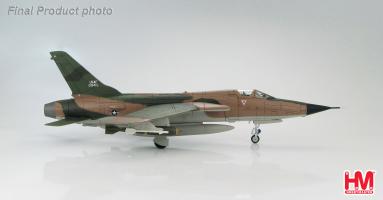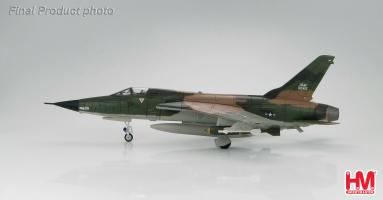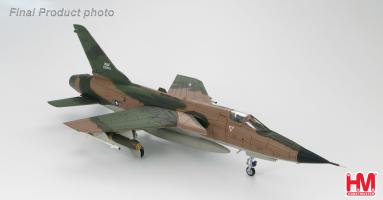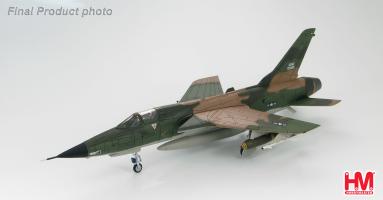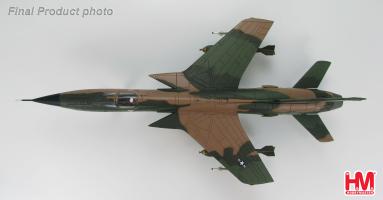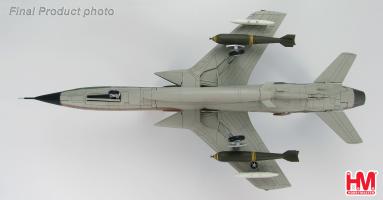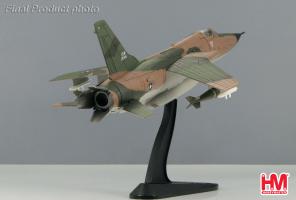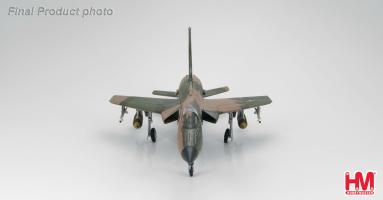Hobby Master Archive
Air Power Jets 1/72
F-105
F-105D Thunderchief 354th TFS/355th TFW, Thailand, 11th Agust 1967, "Dropping the Doumer Bridge"
The F-105D was first accepted on September 28 1960 and became the major variant with 610 aircraft being built. Intended for a nuclear strike role but since the nuclear threat became less likely the role became a high-speed bomber. The Pitot tube was moved to the nose that had been extended approximately 15 inches more than the “B”. The “D” received strengthened landing gear and an arrestor hook in case it over shot the runway. During 1966 and 1967 F-105Ds managed to down 25 MiGs using the 20-mm cannon and 2 other using Side-Winder missiles.
The “Doumer Bridge” was named after Paul Doumer, Governor-General d’Indochine from 1897-1902. In 1954 when the French had been ousted from Vietnam the name was changed to “Long Bien Bridge” but this wasn’t recognized by anyone outside North Vietnam. The bridge was approximately one-mile long and consisted 13 spans that carried two highways and a rail lime. This was a major entry way into Hanoi and was considered a major target by the US. On August 11, 1967 the first attack on the structure was made by 36 F-105s each fitted with two 2,000 pound bombs. The raid had destroyed 3 spans of the bridge but two months later the bridge was operational again. On October 21, 1967 a second raid was made by 21 F-105s and again the bridge was operational two months later. This meant a third raid by fifty F-105s was needed. This time five consecutive spans were put out of commission and stayed like that until March 1968 when US President Johnson halted the bombing. The strike force on the bridge would be led by the 355th TFW. The 354th TFS was activated on November 12, 1942 until November 20, 1946. On November 1, 1952 the group was re-activated but only until January 1, 1958. On April 13, 1962 the 354th was once again brought back and lasted until April 30, 1982.
Specifications for the Republic F-105D Thunderchief Nick Names - Ultra Hog, Super Hog, Iron Butterfly, Lead Sled, Thud Role - Fighter/Bomber User Countries - U.S.A.
Crew - (1) pilot Dimensions Wingspan - 34 ft 11 in, Length - 64 ft 3 in, Height - 19 ft 8 in, Wing Area - 385 sq. ft.
Performance Engine- (1) Pratt & Whitney J75-P-19W turbojet, rated at 17,200 lb.s.t. dry and 26,500 lb. s.t. with afterburner Maximum speed - 1,420 mph at 38,000 ft 1,372 mph at 36,000 ft 1,122 mph at 50,000 ft 836 mph at sea level Stall speed - 208 mph Initial Climb Rate - 34,500 fpm (clean) Service Ceiling - 32,100 ft Combat Ceiling - 48,500 ft Maximum Ceiling - 50,000 ft Combat Range - 778 miles Maximum Range with full external fuel - 2,208 miles Fuel Normal Internal Fuel Load - 1,160 US gallons Internal Weapons Bay - 390 US gallon auxiliary tank Optional 450 or 650 US gallon external tanks on the fuselage centerline Plus a 450 US gallon tank on each of the inboard under-wing pylons Weights Empty - 27,500 lbs Combat - 35,637 lbs Gross - 48,400 lbs Maximum Take/Off - 52,546 lbs Armament (1) 20-mm M61A1 rotary cannon with 1028 rounds (fire rate 6,000 rpm) Up to 8,000 lbs of ordnance could be carried in the internal weapons bay An additional 6,000 lbs of ordnance could be carried on (4) under-wing pylons and (1) rack under the fuselage center-line Up to (4) AIM-9 Sidewinder missiles for self-defense Up to (4) AGM-12 Bullpup (not very effective in Vietnam) (1) Mk 28 or Mk 43 nuclear weapon Up to (2) 3,000 lb bombs Up to (5) 1,000 lb bombs Up to (16) 750 lb bombs Mk 77 napalm ECM pods 2.75 in. rockets
Hobby Master 1/72 Air Power Series HA2506 F-105D Thunderchief 354th TFS/355th TFW, Thailand, 11th Agust 1967 “Dropping the Doumer Bridge”
Die-cast metal. Superb detailing in 1/72 scale. Pre-painted with pad applied markings. Fully assembled. Weapons that are not permanently attached. Comes with crew figure. Display stand included. Option to display model with wheels up or down. Minimum use of plastic.
| Added to archive | 2015-11-19 |
| Last modified | 2015-11-19 |
| Leaflet | 2010-06-01 June 2010 |

